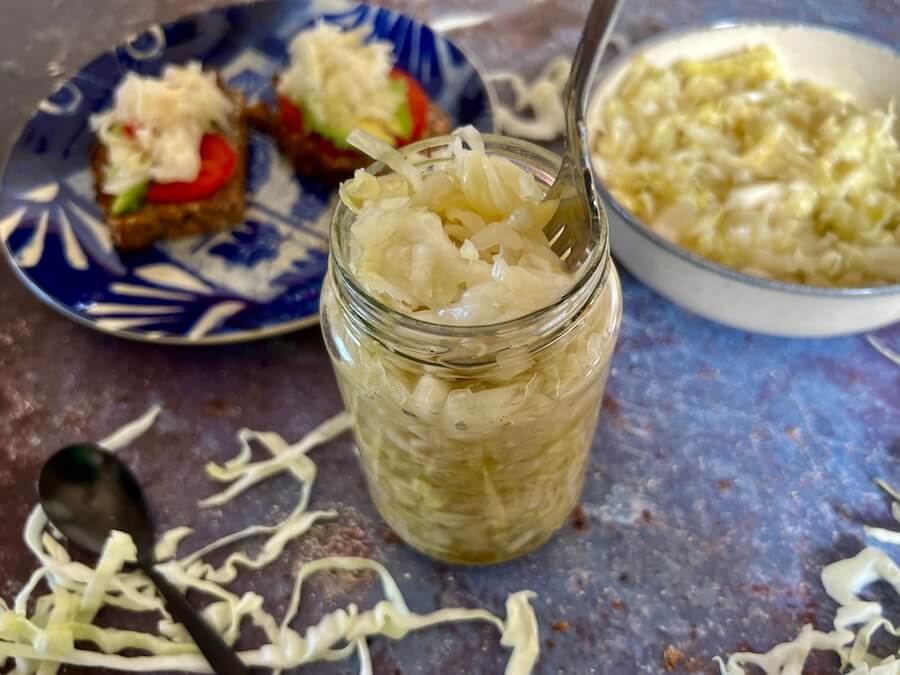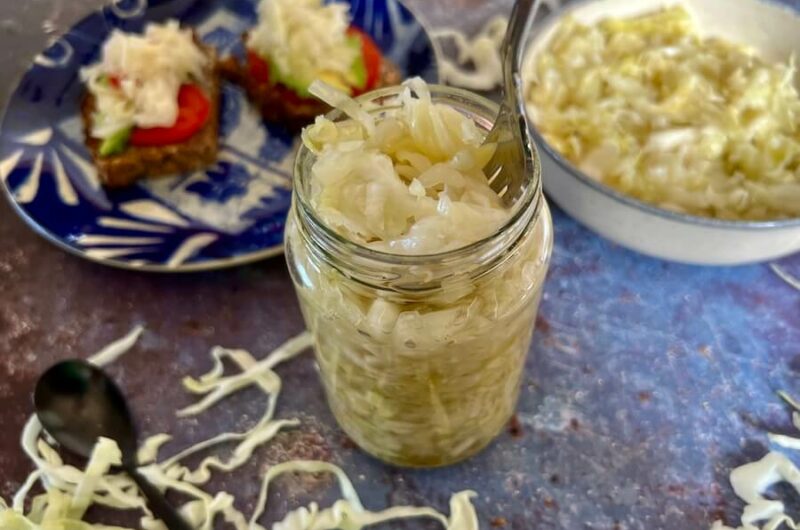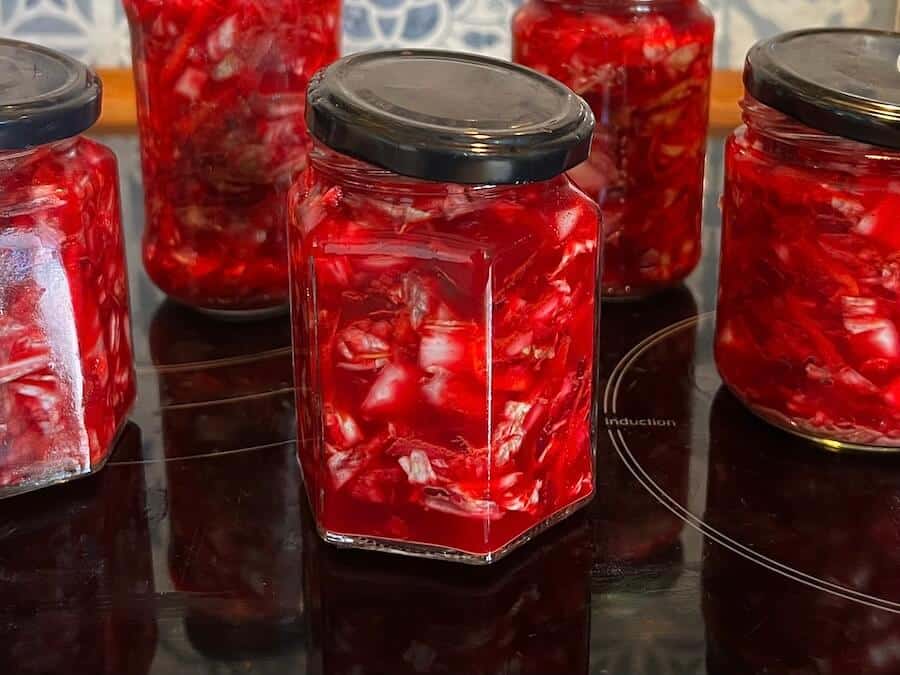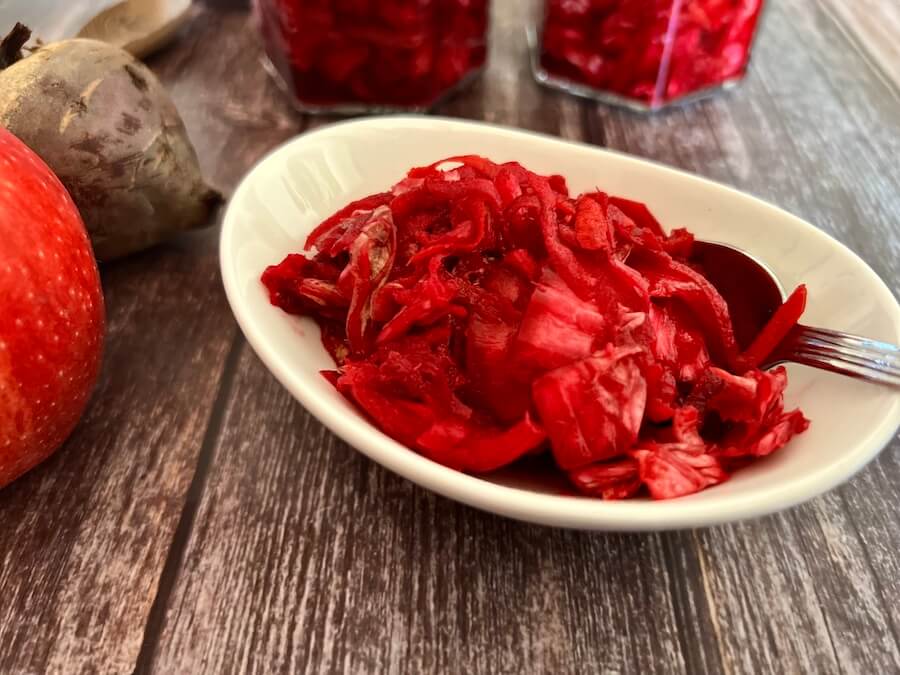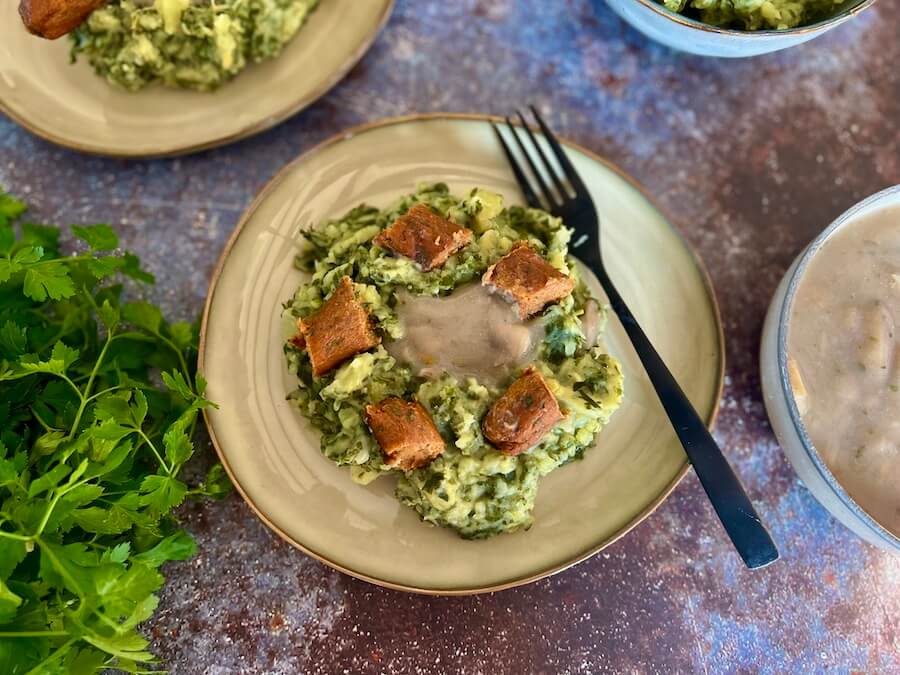Is sauerkraut vegan friendly? Absolutely!
You’ll be pleased to know that sauerkraut isn’t just vegan friendly, but also one of the most healthy foods you can choose to eat on a regular basis.
Teeming with probiotics, a daily dose of (live) sauerkraut (or kimchi) can work wonders for your health.
Table of Contents
What is Sauerkraut?
Sauerkraut’s a German national dish which is actually fermented cabbage. The name itself translates as sour cabbage.
The great news is that sauerkraut is made with just salt and no other (essential) ingredients, although you can add other ingredients if you want.
When salt’s rubbed into the cabbage, it releases a liquid, which together with the salt becomes a brine. Over the space of a few days healthy ‘good’ bacteria start to multiply.
By the time you eat the sauerkraut, it will be teeming with live bacteria.
What are Probiotics?
The term probiotics refers to a mix of live bacteria and yeasts which are considered beneficial to our health. In fact, we have trillions of ‘good’ microorganisms living within our digestive tract.
They are present in all fermented foods like sauerkraut.
In fact, kimchi and sauerkraut are two of the most popular fermented foods you can make. (You might be interested in reading about which is healthier, kimchi or sauerkraut).
While most people think of bacteria as being disease-causing, actually we need a balance between good and bad bacteria in the body in order to be healthy.
When the bad bacteria are over-prolific or the good bacteria are depleted, health issues abound. The addition of good bacteria to the diet will help to return a healthy balance of bacteria to the digestive tract.
Probiotics form a part of the microbiome, and the microbiome’s a field which is under continuing scrutiny in the scientific world because of its power over our general health.
I mean, did you know that your bad mood could, in fact, be because of your microbiome?
How Can Probiotics Help You?
We have trillions of microorganisms living within our digestive tract, including both good and bad bacteria. Often, the bad bacteria overpopulate the space, for many diverse reasons, from health issues to taking medicine or from limited diet choices to name a few.
Including probiotics in your diet helps to reintroduce the good bacteria and balance the system, reducing the bad bacteria and helping a plethora of health issues such as IBS, obesity, mental health issues, allergies and more.
Scientific studies have linked the gut microbiome to mood and mental conditions such as anxiety, depression, autism spectrum disorder, obsessive-compulsive disorder, and memory. Taking probiotics daily for a period of 6-8 weeks has been shown to improve these conditions.
Probiotics (or specific strands of probiotics) are also believed to promote heart health and may reduce the severity of allergies and eczema in children. Although more research is needed, it’s believed that eating probiotics on a daily basis can boost your immune system and reduce the occurrence and likelihood of infections.
OMG the list of possible benefits from eating probiotics is so long it even includes weight loss!
Why You Should Make Your Own Sauerkraut
The jury is definitely in. Probiotics are good for you. Nobody claims otherwise. The only question remaining is: are all probiotics the same?
Well, although there probably are some good products out there (don’t ask me to name them though), there are several problems inherent with buying probiotics.
First of all, probiotics are live microorganisms which will die if they aren’t in optimum surroundings. So while you might be taking great care to store your probiotic capsules correctly, you don’t know what happened to them before they arrived on your doorstep.
In other words, they may already have zero value.
And what about buying sauerkraut in the supermarket? Well, first off and most importantly, some sauerkraut’s been pasteurised so won’t contain any live probiotics whatsoever. If you buy it off the shelf in a tin, forget about the live bacteria because there won’t be any.
For sauerkraut to be live, it needs to be stored in the fridge department rather than the shelf. But even then, there’s no way of actually knowing the bacterial content of commercially sold sauerkraut.
So the best thing to do? Make your own.
Easy.
Hands down the best flavour and you know what the best news is already . . . simple to make. Yes. Sooo simple once you’ve done it and got past the I-don’t-know-how-to-make-sauerkraut blockage.
How Can I Make My Own Sauerkraut?
This is it guys. Get a big bowl out and one cabbage. It can be green or purple, whichever you prefer. Green cabbage is the more traditional choice for making sauerkraut.
Wash the cabbage well and remove the outer leaves, setting two large ones aside for using in a minute.
Cut your cabbage in half and remove the very tough stem (i.e. cut a triangle out of the half-cabbage). Weigh the cabbage so that you know how much salt to add.
Next, lay the half cabbage face down and slice very finely, as thin as you can, so that you end up with shredded cabbage. Place the shredded cabbage into the big bowl.
Sprinkle over the salt and rub it into the cabbage, scrunching the cabbage between your hands, then cover the bowl with a cloth and leave it to stand for an hour. (The exact time it stands isn’t important, it just needs time to sweat out some liquid.)
Get a clean mason jar or similar large jar – it doesn’t need to be sterilised, just regular clean will do – and fill it with the cabbage. Pour the liquid over the top and press it down as much as possible, using a potato masher for example.
Cover the top of the cabbage with the leaves you set aside. Take a regular jam jar and fill it with water. Stand it on top of the cabbage and press it every so often, to keep the cabbage below the liquid level.
Cover the mason jar with a tea cloth or a lid which allows air to circulate and leave to stand.
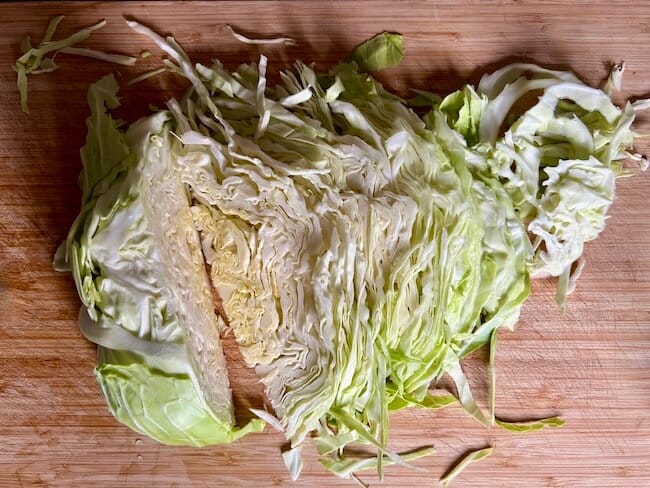
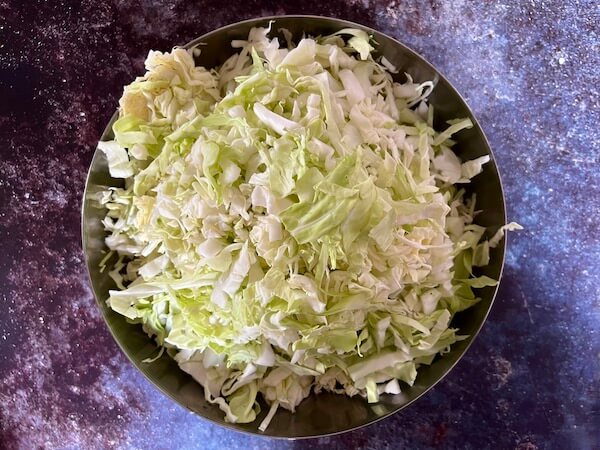
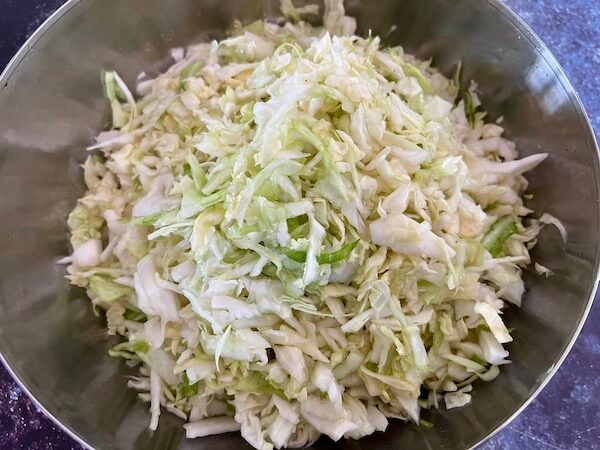
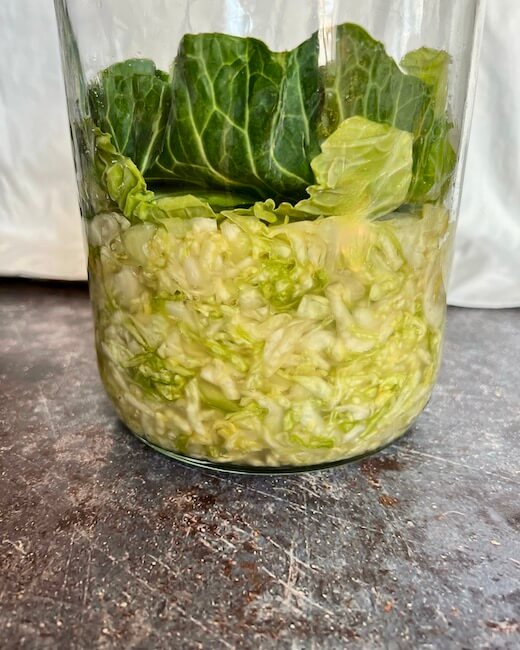
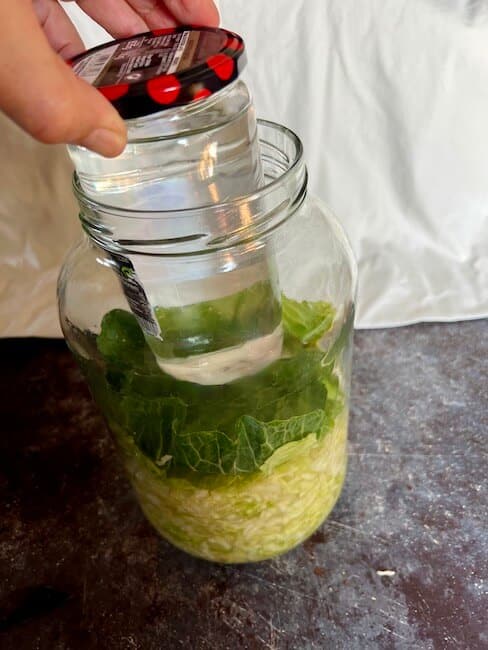
Sauerkraut ferments best at 18-22ºc and takes about 3 weeks to reach its full potential. When you’re starting out, it can be difficult to wait so long.
I would suggest trying your sauerkraut after about 7 days. If you’re happy with the flavour, eat it and prepare a second batch to experiment with leaving longer.
There’s no harm in eating sauerkraut earlier, it just won’t have the same benefits as a more mature version.
What Can Go Wrong With My Homemade Sauerkraut?
Firstly, I really want to repeat that sauerkraut’s easy to make. But like anything, of course there are some things that can go wrong.
The most difficult issue, because it’s out of your hands, will be the temperature where you are fermenting the cabbage. If you live in a hot country, summer isn’t the best time to try to ferment. It speeds everything up so fast that the cabbage may go off too fast.
If you live in a very cold house/country, you may have to wait longer for your sauerkraut to ferment.
If it happens to you that a batch goes wrong, don’t make up a story that you can’t make sauerkraut, just throw it away and start again. No biggie.
It’s just one lost cabbage put down to experience, that’s all.
So without further ado, these are the things that can go wrong.
- The cabbage ferments too fast – you live in a hot climate and the conditions are too hot. Reduce the fermentation time to fit the conditions.
- The cabbage isn’t fermenting – too much salt can slow down the fermentation process. Just be patient and wait a bit longer.
- The cabbage has gone soft and smells off – not enough salt and the fermentation process won’t happen and the cabbage will go bad. Throw it away and start again.
- There’s mould growing on top of the cabbage – this is where the cabbage has made contact with oxygen. To avoid this from happening make sure the cabbage stays below the liquid at all times. If there’s a little mould, you can remove the top layer and make sure the rest is kept below the brine level.
- The sauerkraut doesn’t have much flavour – using an old cabbage really spoils the point of sauerkraut and give a flavourless result. Use as fresh and young a cabbage as you can get your hands on.
- The cabbage doesn’t release enough liquid to cover the shredded cabbage. – again, using an old cabbage can result in less liquid being released. To remedy it, make a little brine using filtered water and salt (1 tablespoon to 4 cups of water)
What to Eat With Sauerkraut
No joking here, sauerkraut goes with almost everything.
One of my favourite breakfasts is a lovely ripe fresh avocado sliced up with sauerkraut and heavily sprinkled with ground flax seed.
For lunch, a vegan bowl with sauerkraut on the side has to be one of my number one pleasures in life!
But if I were to list all the foods that you can eat sauerkraut with, it would be never ending! A stir fry with sauerkraut, an easy black bean burger in a gluten free bun or some oil free scalloped potatoes or zero oil roasted vegetables.
Just get into the groove and you’ll find yourself adding it to everything.
Homemade Sauerkraut Recipe
Course: Side dishCuisine: Probiotic, FermentedDifficulty: Easy4
servings30
minutes40
minutesSo delicious and so healthy. Make this easy sauerkraut and enjoy with every meal!
Ingredients
1 green cabbage
Salt (without added ingredients)
Directions
- Wash the cabbage and remove at least two of the outer leaves for using later.
- Cut the cabbage in half and remove the tough stem.
- Shred the cabbage by finely slicing with a knife.
- Place into a large bowl and sprinkle over with salt. Use 2% salt by weight.
- Massage the salt well into the cabbage.
- Cover with a tea cloth and set aside for a couple of hours.
- Pack the cabbage into a large mason jar (or use something similar) and press down well (you can use a potato masher to press it down).
- Cover the top with the two leaves which you set aside before.
- Make sure that all the cabbage is below the liquid. Add a closed jar of water on top to weigh down the cabbage and keep it submerged in the liquid.
- Leave for at least 5-6 days. It can continue to ferment for weeks or you can eat it after just a few days. Taste it and decide accordingly.
- Transfer the sauerkraut into smaller jars, press down well, again below the liquid level, and close with a good fitting lid.
Homemade Sauerkraut Video
Notes
- Eat sauerkraut every day to promote a healthy microbiome and improve overall health.
Which do you prefer, sauerkraut or kimchi?
